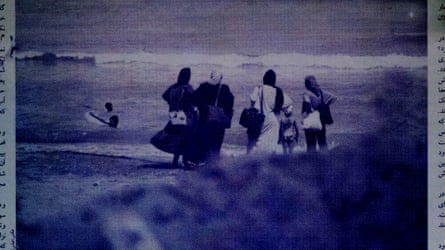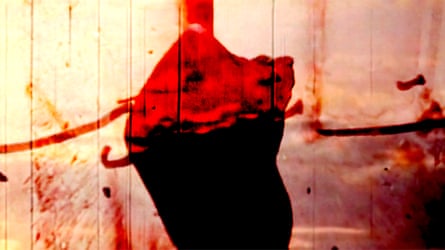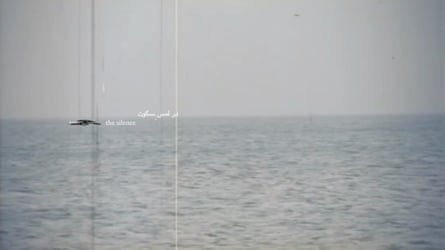In the first weeks of the pandemic, Maryam Tafakory set herself the task of watching 417 films made in post-revolution Iran. She soon found something curious: the recurring use of bags. Objects such as bags are often deployed by film-makers as substitutes for actual physical contact between a man and a woman, in a country where such depictions of intimacy are prohibited.
Focusing on films spanning nearly three decades, the UK-based artist built on research she originally began three years earlier for her PhD, to create several films and video essays. The first is Irani Bag, which uses a clip from a 1992 Iranian production, The Song of Tehran and features a couple seen from behind each holding a strap from the same bag, instead of taking each other’s hands. “Learning to touch without touching,” says a text inserted alongside split-screen videos in the 2020 work. In another clip, a bag is used to separate two actors sat on the back of a motorbike.
“I grew up with this archive,” says Tafakory, who has just won the 2024 Film London Jarman award and its £10,000 prize. “These are films I both fell in love with and felt betrayed by. Irani Bag uses a simple prop, bags, to suggest that censorship often does the opposite of what it intends. It’s in the prohibition of touch that words, objects and glances conspire; they become mediators, skin prosthetics – and sensual. They remind us that touch is never erased, but fetishised.”
Tafakory, whose work mixes cinema and live performance, created a series that she calls “a rage against the archive”. Using techniques including mirroring, inversion and superimposition, she creates layered compositions and collages replete with sonic textures from archival sound, as well as on-screen texts.
Irani Bag was followed in 2022 by Nazarbazi, focusing on images of women “whose bodies have been obscured and victimised”, then by Mast-del, a blend of fiction and non-fiction that uses both original and found footage. It is about a forbidden relationship between two women, a subject that can never get censors’ approval in Tafakory’s homeland.
Born and raised in Iran, Tafakory’s upbringing coincided with a relative opening-up of Iranian cinema, when the number of newspapers appearing in stands also significantly increased. Iranian cinema, she says, “is glorified in the west for its allegorical resistance, while at home it faces criticism for its complicity with state repression, acceptance of censorship, and normalisation of gendered violence”.

She goes on: “I wanted to make something that doesn’t fall into this reductive binary. I’m not interested in clarifying cinematic codes for non-Iranians. My films resist the oversimplifications often found in western misreadings of Iranian cinema.”
Tafakory’s latest work, Razeh-Del, tells the story of Iran’s first women’s newspaper, Zan (Woman), which was published briefly from 1998 to 1999. Two schoolgirls send a letter to the newspaper, “the synopsis for an impossible film”, in an echo of the illicit love story in Mast-del.
Razeh-Del is dominated by saturated hues of amethyst, crimson and amber, interrupted by snippets of fleeting newspaper clips and texts primarily taken from the newspaper’s readers’ comments column. The film highlights the erasure of women from both the cinema and the press. “The court’s verdict against Zan is fair,” comments one reader, “you deserve harsher condemnation.”

Tafakory, who deploys “an overdose of words” in the work’s four parallel story lines, says many reader comments targeted the very title of the newspaper, as well as “its appearance, ink colours and fonts”.
Tafakory is revisiting the archive “to write on to them the stories they never told us, and talk about what has always been buried in plain sight. I want these images to confess. Misogyny and the absence of queer narratives are inseparable from the identity of post-revolution Iranian cinema.”
For her generation, cinema seemed “an escape from the police at home, the ones at school, the ones on the streets”. Even in the dark of a theatre room, “there were watchmen who would come with a torch”. She realised later in life that cinema “was often an escape to a deeper form of repression”.
Tafakory dropped out of her university in Iran in 2007, then did the same when she went to Southampton University to study computer science. She later secured her master’s in fine art at Oxford before doing a PhD at Kingston University.
During our hour-long interview, which took place just before the Jarman winner was announced, Tafakory came across as meticulous, particularly with words. “I would prefer to be with a pen and paper,” she says, explaining why she rarely does interviews. She walks a tightrope both in her work and the interview. Irani Bag, in its title, contains a subtle reference to a popular Iranian TV series named The English Bag. Aired in 1999, it’s about British interference in the Iranian politics of the pre-revolution era.

She remains critical of how Iran is portrayed in the west. “The stories and images of Iranian women have long been co-opted and manipulated to serve a western agenda,” she says, especially “when they align with their aim to widen the conflict in the Middle East.”
In a reference to the Woman, Life, Freedom movement, Tafakory feels compelled to give people this reminder: “Iranian women’s resistance neither began nor ended in 2022. Woman, Life, Freedom changed something that cannot be unchanged. We have already imagined a freedom that cinema never dared to.”
This post was originally published on here







